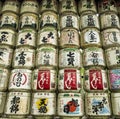Find results that contain all of your keywords. Content filter is on.
Search will return best illustrations, stock vectors and clipart.
Choose orientation:
Make it so!
You have chosen to exclude "" from your results.
Choose orientation:
Explore cartoons & images using related keywords:
barrels
decoration
emperor
harajuku
japan
jing
kazaridaru
meiji restoration sake shoken srine tokyo torii wine yoyogiSake Barrels At Meiji Jingū Srine, Tokyo, Japan Editorial Image
Designed by
Title
Sake Barrels at Meiji Jingū Srine, Tokyo, Japan #123068726
Description
Meiji Shrine æˎ治神宮, Meiji Jingà «. Located just beside the JR Yamanote Line`s busy Harajuku Station, Meiji Shrine and the adjacent Yoyogi Park make up a large forested area within the densely built-up city. The shrine was completed and dedicated to the Emperor Meiji and the Empress Shoken in 1920, eight years after the passing of the emperor and six years after the passing of the empress. The shrine was destroyed during the Second World War but was rebuilt shortly thereafter. Emperor Meiji was the first emperor of modern Japan. He was born in 1852 and ascended to the throne in 1867 at the peak of the Meiji Restoration when Japan`s feudal era came to an end and the emperor was restored to power. During the Meiji Period, Japan modernized and westernized herself to join the world`s major powers by the time Emperor Meiji passed away in 1912. Entry into the shrine grounds is marked by a massive torii gate, after which the sights and sounds of the busy city are replaced by a tranquil forest. The approximately 100,000 trees that make up Meiji Jingu`s forest were planted during the shrine`s construction and were donated from regions across the entire country. Sake barrels are called kazaridaru, which means ââ¬Ådecoration barrels.ââ¬Â As you surmised, the barrels on display are empty, at least in physical terms. Spiritually, theyââ¬â¢re chock full of significance.
This image is editorial















